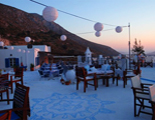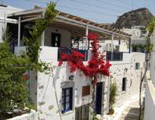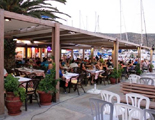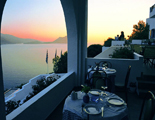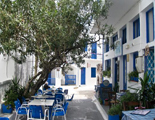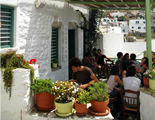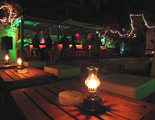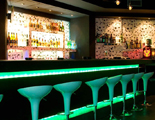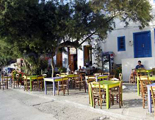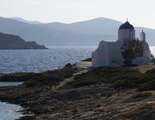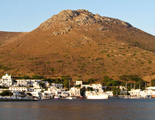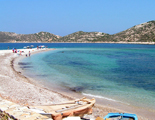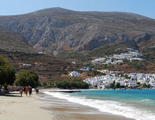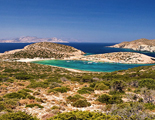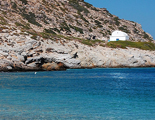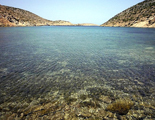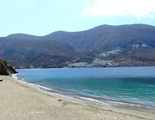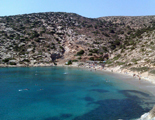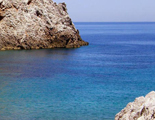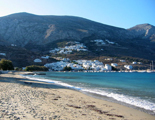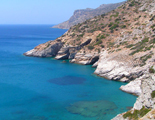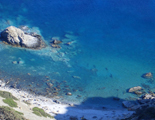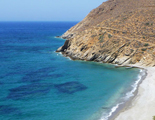 Amorgos Travel Guide
Amorgos Travel Guide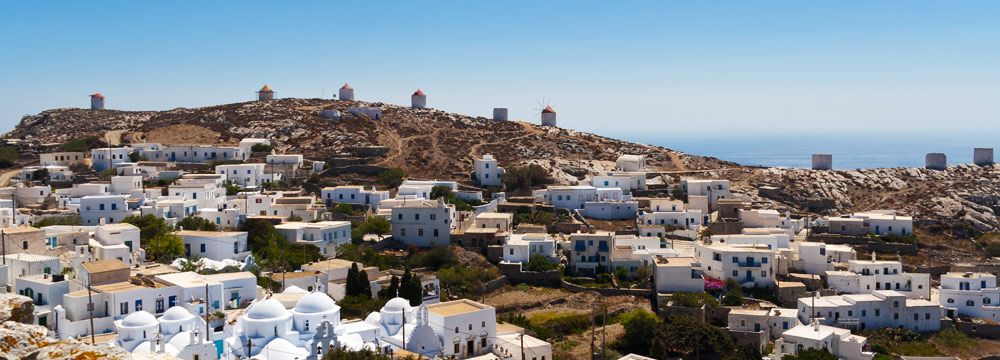
Amorgos Island is also referred to as Hyperia, Patagi, Pagali, Psichia and Karkesia. The name changed to Amolgon, Amourgon, Amorgian and Amourgian. In the 5th century A.D the name Amoulgos is encountered in the signature of Bishop Theodore in a Synod that took place in Constantinople.
Amorgos has two natural ports, Katapola which is the main port, and Aegiali. Both are located on the north coast and the capital of the island is called Hora, like in most Greek islands.
The findings indicate human existence on the island from the late 4th millennium B.C., the end of the Neolithic period. It was one of the most important centres of the ancient Cycladic civilization and had remarkably developed trade, marine navigation, arts and educational activities. The findings from the excavations (coins, tombs, tools from stone, inscriptions, vessels, etc.) and the remnants of fortification walls and towers scattered around the island, show that Amorgos had an dominant presence during the first period of the Cycladic Civilization (3200 to 2000 B.C). The island was famous for producing fine garments made of flax material, which was cultivated on the island and was called amorgos.
Due to its location on the map, right opposite important ancient Ionian cities such as Militos, Alikarnassos and Efessos, Amorgos played a major role in the immigration of both the Cyclades and the Greek mainland by Ionian populations.
In 337 B.C. the Macedonians took over the island and in 322 B.C. the battleship of Amorgos took place between the Macedonians and the Athenians. The former not only won but also completely crashed the naval power of the Athenians.
Under Roman Rule the island declined and had to pay an annual tax. It also served as a place of exile during that time.
During the Byzantine Era the island was part of the Province of the Islands which had as its capital the island of Rhodes. The monastery of Panagia Hozoviotissa, built in the 11th century, is the most important monument of that era still standing.
Alike the rest of the Cycladic Islands Amorgos suffered from consecutive pirates’ predation which led the local population to abandon the island and migrate on other areas. In 1269 Jeremiah Gizis organized the island’s defense by building the Frankish castle in Hora which helped in the re-colonization of the deserted island. After the death of the later and his heir, many Houses ruled the island.
Venetian nobles contended for the island, until 1537 when the Turk Admiral Barbarossa took over the island. The Sultan granted political and economic privileges to Amorgos that highly contributed to its prosperity, thus surpassing a long period of instability.
In 1751 a Greek School in the Monastery of Agia Marina was also founded. The lack of fertile land and of natural resources once again forced a part of the population to migrate to Constantinople and to Asia Minor.
Raids from Mani caused severe disasters in 1797.
During the Russian – Turkish war in 1806 the island was under Russian Rule and in 1808 passed under the English naval squadron of the Mediterranean. In 1821 it took part in the Greek revolution against the Turks and officially joined the newly established Greek State in 1832.
During the Minoan Era, the Minoans founded the city of Minoa on the island. King Minoa is supposed to have also ruled the island of Amorgos, except for Crete, that is why there are Minoan remnants and a city named Minoa on the island.
Another version supports that Minoa was a colony of Samos. Arkessini was a colony of Naxos located in the area where the city of Kastri is found today and the Milecians founded Aegiali, which today is the village of Tholaria. Those three cities were the most important and developed of the island and formed the Commonwealth of Tripolis (meaning three cities).
Hora is the capital of the island. You can tour around the narrow cobbled streets, admire the old traditional mansions, the whitewashed churches and you will also have the chance to visit the hill with the windmills offering fascinating views of the Aegean Sea. The streets lead to Loza and the old Castle right at the highest spot in the middle of the settlement. In the old mansion of Gavras one can find historical findings from the island.
Standing gracefully right above Hora, the Venetian Castle resembles mostly a huge rock mass with fortification walls that dates back to the 13th century, built by Ieremias Gizis in order to protect the island’s main settlement for invasions. Naturally, the castle offers breathtaking views to the majestic scenery of Hora and the Aegean Sea.
To enter the monastery one has to ascend 300 stairs. It is built in a beautiful rough place over steep rocks, literally hanging over the void. It was constructed in 1088 and was renovated by the Emperor of the Byzantium Aleksios Komninos.
According to the tradition the reason for its construction was the image of Holy Mary found on the spot, which originally came from Hozovo (or Hozova) of Palestine during the persecution of Christians in the 9th century. Architectural interventions and changes that altered its prime character were made during the Venetian Rule (1296-1537).
During the Turkish Rule (1537-1824) the monastery managed to keep its state of prosperity due to its big fortune (including lands in Crete, Naxos, Paros, Astypalaia, Ios, Leros and other islands).
This served as a medieval cistern providing water to the population of Hora during the Byzantine Era. Nowadays its form is like a cave with a water pool which was finalized during the Venetian times.
Right next to Katapola, this ancient town, you will meet the ruins of the ancient town “Minoa”, believed to have been named after King Minoa of Crete, as he is thought to have ruled on Amorgos too. Various findings and the ruins of a settlement prove that this was one important town hundreds of years ago. A stroll through the ruins and the aura of the past will take you over here too as in most archeological sites in Greece.
Various legends and stories are wrapped around this Post Byzantine monastery which was built on the remnants of an ancient church of the 9th century A. D. and is found near the famous Panagia Hozovotissa Monastery. It is believed that lepers that managed to escape from a pirate ship made their way out here from Hora and found a natural water spring with mint growing all around it. After they settled here, their illness disappeared and since a holy icon of St. George was found there, the monastery was built to honor the saint and the miracle.
Apart from that, the spring is known to have had miraculous healing properties during the pre-Christian times and its waters flow till nowadays in the middle of the monastery. The priests here claim that they can read a person’s destiny for a glass of water following unwritten rules passed from generation to generation. For trekking lovers, a path from the Monastery leads to the ancient city of Minoa.
A superb building of Venetian architecture dating back to the 16th century houses today the archeological collection of the island of Amorgos. The exhibits vary from the Copper Age objects to utensils and findings till the ancient times. On the ground floor you will mostly find prehistoric objects and in the first floor you will see sculptures and other art objects.
On Amorgos you will find many towers dating back to the Hellinistic Period but the one found on the south of the island, in Arkesini, is among the most important and well-standing ones. It is believed to have been built during the 4th century B.C. and despite its wrecked appearance you can make out that it had a proper cistern and a kind of plumbing system.
This is a very important sample of early Byzantine times found within an hour’s walk from Lagada village near Aegiali. The natural surroundings are amazing while the monastery is built on the ruins of an ancient temple. Twice each year a great festival takes place here in May 8th and September 26th. Nearby you can also find the church of Stavros through paths carved within the wild nature.
Another great sample of religion and faith, Panagia Katapoliani is found in Katapola and has been built on the ruins of an ancient temple and this is most probably the reason why it is attributed to Apollo the Pitheios. The church is also a marvel of Cycladic architecture.
A plain structure completely attuned with the environment with a length of 40m, 5m wide and 8 floors high with narrow stone-made stairs leading up to them.
Stones from Milos Island and timber were used to the construction of this building used as a monastery. The monastery consists of the monk cells, the cuisines, the ovens, the warehouses, the bakery, the treadle, the cellars, the wells.
The Altar is open to the public on the 21th of November, the celebration day of Virgin Mary.
Also, since 1977, three small cells were united for the visitors to see so that they admire some of the relics of this monastery with the treat of citron and loukoumi sweets.
Nikouria nowadays is an uninhabited islet, located 300 metres from the coast Agios Pavlos, and can be visited by boat from there. According to the findings it was inhabited since the 3rd millennium B.C. and, also, it served as a mine and currency construction site for the ancient towns of Minoa, Aegiali and Arkesini. It has three unspoiled beautiful beaches with sand and pebbles as well, for all tastes. The waters there are cold, clean and crystal clear.
CLIMATE
Amorgos Island is located in the south-easternmost edge of the Cyclades complex. Generally the island has a Mediterranean climate with mild winters and cool summers. In specific it has a microclimate, so the weather conditions may differ from one side of the island to the other.
TELEPHONE
The national prefix for Greece is +30 if you are calling from abroad. All numbers in the capital Athens start with the prefix 210 and are followed by 7 digits (e.g. 210-3227400).
The Area Code for Amorgos is: +30 22850.
If you wish to call abroad, you have to start by dialing the other country’s national prefix (i.e. 0049 for Germany, 0044 for England etc.) and continue with the area code and the number where you wish to call.
CURRENCY
Euro €
Euro Coins: 1 and 2 euro coins (gold and silver color), 10, 20 and 50 cents (gold color) 1, 2 and 5 cents (copper color)
1 euro = 100 cents / centimes.
Euro Bank Notes: Are available in 5, 10, 20, 50, 100, 200 and 500. It is not always easy to receive change for 200 and 500 Euro Notes.
BY AIR
Amorgos is connected by air via Naxos, Paros and Mykonos and from there with the local boat lines.
For more information on flights, please visit:
Athens International Airport Eleftherios Venizelos: www.aia.gr
Olympic Airways: For accurate timetables and ticket costs visit Olympic Air website www.olympicair.com
Athens Office: +30 210 355 0500, 8018010101
Aegean Air: For accurate timetables and ticket costs visit Aegean Air website www.aegeanair.com
Tel.: 801 112 0000/+30 210 6261000
BY BOAT
Amorgos is connected with the port of Piraeus with frequent routes. The trip lasts about 7-9 hours (depending on the stopovers) with the standard boats and 4-5 hours if you take the fast ferries. The island is also connected with the rest of the Cyclades with frequent routes, once a week with the Dodecanese and twice with Astypalaia Island. The boat "Skopelitis Express" connects the island of Amorgos every day with the Small Cyclades.
Blue star Ferries
For accurate timetables and ticket costs visit: www.bluestarferries.gr
Tel.: +30 210 3249 997, +30 210 3319 079, +30 211 2215502
NEL Lines
For accurate timetables and ticket costs visit: www.nel.gr
Tel.: +30 210 4125888, +30 210 4115015
Email: [email protected]
Sea Jets Ferries
For accurate timetables and ticket costs visit: www.seajets.gr
Tel.: +30 210 4121001, +30 210 4121901
Email: [email protected]
Katapola Port Authority: +30 22850 71259
Piraeus Port Authority Tel.: +30 210 4226000, +30 210 4114005
Travel Agencies in Amorgos
Tel.: +30 22850 73032 / 71278 / 71256 / 73393
LOCAL BUSES
The local buses’ routes are frequent and connect all villages and almost all beaches of the island between them.
KTEL Amorgos Tel.: +30 22850 71514, 73003, 72202, 71623, 71253
TAXI SERVICE
Katapola Tel.: +30 22850 71255
Aegiali Tel.: +30 22850 73570
RENT A CAR/MOTORBIKE
The best way to discover the beauties of Amorgos is by renting a car or a motorbike. Rental offices are available in Aegiali, Katapola and Amorgos (Hora). Attention must be given on the roads though because they are usually narrow, winding and not well maintained.
BANKS & ATMS
On the island there are not many branches of Greek banks. There is the Agricultural Bank of Greece in Katapola.
Agricultural Bank of Greece Tel.: +30 22850 71871, 71872
MONEY EXCHANGE
Banks exchange all major currencies, traveler’s cheques or Eurocheques. Post offices exchange cash, but not traveler’s cheques, and usually charge lower commissions than banks. Travel agencies and larger hotels exchange cash and traveler’s cheques but usually charge a higher commission. Credit cards are accepted in shops and restaurants, however, in local cafes, especially in villages you will probably have to pay in cash.
POST OFFICE
The Greek post office is called ELTA. Post Boxes in Greece are YELLOW for normal post, usually with 2 slots for INTERNAL POST (meaning inside Greece) and post for ABROAD. RED Post Boxes are rarer and they are used for URGENT mail. REGISTERED mail is always handled and given a receipt for at the POST OFFICE.
Amorgos (Hora) Post Office Tel.: +30 22850 71250
Aegiali Post Office Tel.: +30 22850 73037
Katapola Post Office Tel.: +30 22850 71496
POLICE STATION
Amorgos (Hora) Police Station Tel.: +30 22850 71210
Aegiali Police Station Tel.: +30 22850 73320
Municipality of Amorgos Tel.: +30 22850 60200
- Tourist Police: 171
- Hellenic National Meteorological service: +30 210 9699101-3
- Elpa (Car breakdown tourist information service): 174
- Amorgos Port Authority: +30 22850 71259
- Naxos Port Authority: +30 22850 22300
- Syros Port Authority: +30 22810 88888
International Press can be found in Katapola and Aegiali.
Aegiali Tel.: +30 22850 73001, 73032
Katapola Tel.: +30 22850 71839
EMERGENCY NUMBERS
- Police: 100
- Fire Department: 199
- Ambulance: 166
Amorgos Health Centre Tel.: +30 22850 71207
Katapola Health Centre Tel.: +30 22850 71805
Aegiali Health Centre Tel.: +30 22850 73222
Arkesini Health Centre Tel.: +30 22850 72250
PHARMACY
Pharmacies can be found in Katapola, in Aegiali and in Hora. Pharmacists are well-qualified to deal with the majority of minor medical complaints or to prepare prescriptions. The opening hours are listed at the front doors or on the windows of each Pharmacy. For your convenience find below some useful pharmacies’ numbers:
Hora Tel.: +30 22850 74166
Aegiali Tel.: +30 22850 73173
Katapola Tel.: +30 2285071400
Mourou beach is located at about 15 km south from Amorgos Hora and can be reached through Arkesini village by an asphalt road for 2 km up to the parking space and then 10’ walk through a path that leads to the beach. The coast is beautiful with pebbles and unique turquoise waters, spread along with imposing rocks, while it is totally not organized apart from a small tavern just above the beach. But the highlight of the beach is the two caves on their one side in which you can swim and explore the magnificent ambience.
Agioi Saranta is located very near Katapola, going leftwards. The beach is sandy with clean and cool waters but also deep so swimming here requires extra caution. Despite that, Agioi Saranta is a very beautiful beach and not crowded as it has no tourist facilities and no natural shade. We suggest that you visit this charming coast but mind to have all necessary supplies with you.
Fokiotripa is located on the northern part of the island, very near Aegiali, at about 15 km from Hora. The beach is mainly sandy with warm, shallow waters protected from the winds by the surrounding cliffs. Thus, it is a perfect option for families with young children. Fokiotripa is usually not crowded, unlike its neighboring Aegialis beach, and it is not organized although you will find some taverns and cafeterias.
Kambi beach is in walking distance from Amorgos Hora and Agia Anna beach and it boasts fine, dark grey pebbles. Kambi or Ammoudi beach is a favorite spot for nudists as it is pretty secluded as it is often windy and the sea is pretty rough. It is surrounded by high cliffs that are ideal for diving and it is completely unorganized, so mind to bring with you snacks and drinks. Another must-visit on Amorgos!
Plakes beach is found near Katapola and it is a beautiful sandy beach with crystal clear waters surrounded by big cliffs that make it seems even more isolated from the rest of the world and protect it from the winds. The sea world is abundant here so diving and snorkeling are among the best things to do when you visit Plakes. Since near Katapola a series of small beaches can be found if you follow the paths, there is a high chance that you will have total privacy here.
Psili Ammos is located at about 2km from Aegiali, right after Levrossos beach. It boasts a beautiful sandy coast with transparent and clean waters protected from the winds by the steep surrounding cliffs that are also verdant. As the waters are mostly calm, it is a perfect spot for diving and snorkeling and it also offers some natural shade from the existing tamarisk trees. Psili Ammos can be accessed on foot from Aegiali but we suggest that you take instead the small boat from there which only takes a certain amount of visitors to the coast due its size.
Patatato is the most famous traditional dish in Amorgos. It is made with goat, red sauce and potatoes. It is prepared usually in religious feasts, weddings and special occasions and it is really a mouthwatering dish!
The traditional Easter dish, also known as “Psito tis Labris”, is made with stuffed goat with rise, viscera, dill and rosemary, cooked in the traditional ovens. One of the island’s local delicacies for meat lovers.
A special summer dish found at most taverns throughout the island. The dish is made with fried aubergines that are put in a baking pan in layers among which a tomato sauce with cinnamon, cloves, onion and garlic are laid together with the sour and soft ksinomizithra cheese.
It is a kind of soup made with goat, viscera and garlic served in traditional feasts. And of course vinegar, as Ksidato in Greek means “with vinegar”. Ksidato is mostly served after the wedding day to relatives and friends of the couple in order to smooth the stomach ache after the reception’s eating & drinking.
A delicious sweet made with dough that is ply cut, folded and then fried. Honey, cinnamon and sesame are added on top. Kserotigana is mostly a Christmas sweet and a typical, indispensable treat for weddings along with pasteli.
In Amorgos pasteli sweet is made with honey, sesame but the result is softer than the usual pasteli and also has a small dose of cumin. It is served on a lemon leaf which contributes in the final, unique flavor.
This is a local homemade liquor made of boiled raki, honey, spices and dried fruits in many variations. A product for which Amorgos is famous, not to be confused with rakomelo!
The most common drink in Amorgos is made with boiled raki with honey and some cloves. It is strictly served hot!
Maybe fava from Santorini is famous; nevertheless fava from Amorgos is also special due to its sweet flavor.
This is a very rear product that only grows on Amorgos resembling beans but it needs special process before it is cooked so as not to be too bitter and unpleasant. It is mostly eaten with oil and lemon, like the white beans.
Amorgos produces a special type of fresh goat cheese, using only traditional production methods, called malaka, which means very soft.
Amorgos produces fine quality honey due to its massifs and its natural wealth in flowers and herbs.
Every year in the beginning of August in Hora, the Pasteli Feast is organized by “Simonides” local Cultural Association. The local sweet makers explain and present the preparation method of this traditional sweet which is then offered to the guests. The event is accompanied by live local music, raki and dance.
Easter period in Amorgos is an experience not to be missed due to its unique combination of traditions, customs and the magical spring scenery. The roads in Langada, from where the Epitaph passes the night of Good Friday, are paved with herb piles, which emerge aromas when tramped by the pilgrims’ procession. The same custom is followed in Tholaria during Easter night.
The Procession of the images of the Monastery to the entire island is the flagship of the Easter Customs. On Easter Sunday a team from every part of the island visits the Monastery of Hozoviotissa on foot where they are given a copy of the Holy Mary icon. Until the following Sunday of Saint Thomas the locals wander always on foot from place to place visiting as many churches as possible and then the Holy Icon is returned to the Monastery.
The roots of most religious feasts of Amorgos are extended to the ancient years. The day of the feast the locals collect the ingredients to prepare the local traditional dishes “patatato” and “ksidato”, which are consecrated by the priest and then offered to the guests.
The most famous religious feasts are:
- The feast of Agia Paraskevi held in Kalofana on the 26th of July.
- The feast of Ascension held in Potamos (movable feast, 40 days after Easter).
- The feast of Agion Anargiron held in Tholaria on the 1st of July.
- The feast of Holy Mary Epanohoriani held in Langada on the 15th of August.
- The feast of Agios Ioannis Theologos held in Kroukelos on the 8th of May and on the 26th of September.
The hiking lovers will be thrilled by the numerous trails which, until the end of the 80’s, served as the main of communication between the villages of the island. Six principal trails are marked and mapped to a hiking guide:
- Palia Strata: Hora - Hozoviotissa - Kapsala - Asfontilitis - Potamos – Aegiali.
- Fotodotis: Hora - Milies – Agia Irini – Katapola.
- Itonia: Lefkes – Agioi Saranta - Kamari - Kastri - Vroutsi - Rahoula – Arkesini.
- Melania: Aegiali - Langada - Stroumbos - Epanohoriani-Tholaria - Fokiotrypa.
- Pan: Langada - Theologos – Stavros.
- Valsamitis: Katapola - Agios Georgios Valsamitis - Agia Marina – Minoa.
Amorgos' beaches are not the typical long sandy beaches of other Cycladic Islands. They are mainly rocky with pebbles and an extraordinary seabed of diverse geomorphology. No wonder why the “Big Blue” movie was shot here! So, we suggest that you always have with you your snorkeling and fishing equipment and that you are prepared for endless underwater explorations and diving adventures! Also, many beaches, especially the most isolated ones, are perfect for nudism.
Visit the monastery late afternoon so as to avoid being sun burnt and that you have the chance to enjoy undisrupted the breathtaking view. Keep in mind though that 7 pm is the closing time.
The best way to discover Amorgos’ secret treasures is by visiting it with a yacht. This way you will have the chance to access its beautiful coves only accessible through hiking paths after some time of walking and even see those ones only accessible by boat. One of those is the beach right beneath Panagia Hozoviotissa Monastery.
Either on foot, bus or private vehicle, Amorgos is an island that calls to be explored. We would suggest renting a car or motorbike so as not be constrained by buses’’ timetables. Most rent a car agencies are located in Katapola and Aegiali and you should expect the prices are a little higher that the other Cycladic islands. In case you choose bus for your transportations, mind to check the timetables one day before your excursion so as to avoid delays or even cancelations. When you drive on Amorgos mind the strong winds which are pretty rough in certain places especially the ones of high altitude.
The small taverns within the alleys of Hora are a must visit as well as some bar in Hora where live music is performed and a nice small crowd is gathered with cheerful mood and nice drinks. Of course, rakomelo is the main “attraction” of the nightlife but do not overdo it as its sweet taste and the high alcoholic degrees will can you into wanting more and more but it will soon have an effect on your organism and balance! So, enjoy responsibly especially if you are driving!
Kisiri means the islet of pumice as it is full of this light, white mineral. It is believed that this was the outcome of the last explosion of Sanotirni’s volcano that Kisiri with this heritage. The islet is found at the southernmost part of Amorgos and it is a perfect choice for nature lovers and bird-watching fans. You may also be lucky enough to see the sea gulls training their little ones and some seals or the sea turtle of Amorgos.
On Amorgos you will find an array of shops that sell traditional products of the island mostly in Katapola, Aegiali and Hora which are the most popular places. But, we also suggest that you take a walk in other villages and settlements as pleasant surprises may await in hidden places.

 Print this page
Print this page